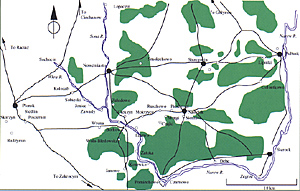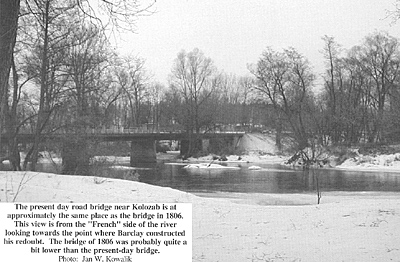Action at Kolozab
24 December 1806
The Situation
by Robert Goetz, USA
| |
The action at Kolozab (called Kolozomb by the French) was the second of three actions in which the French sought to force crossing of the Wkra river on 24 December 1806. Like the similar action at Borkowo a short distance downstream, the action at Kolozab resulted in Russian withdrawal.
Unlike Borkowo, the French made a serious effort to rapidly seize the bridge under enemy fire, incurring significant losses as a result. English language descriptions of the battle are vague and confusing regarding both the Russian forces deployed and the course of the action. By placing the action in the context of the other actions on the Wkra, it is possible to clarify both the forces involved and the broader significance of the action.
Early in the morning of the 24 December 1806, French columns marched on three points in the Russian defensive line – Borkowo, Kolozab and Sochocin. The first of these posts was defended by a small force under the command of Major General Ivan Semenovich Dorokhov while the defense of the latter two points fell to Major General Mikhail Bogdanovich Barclay de Tolly. Barclay had commanded the Advance Guard of the corps of Lieutenant General Levin Bennigsen, composed of forces drawn from the Russian 4th division. With the withdrawal of the Russian forces to the Narew-Wkra line during the first ten days of the month, Barclay’s force was positioned on the right of the first line of defense along the Wkra River. Barclay’s job was to secure the Russian right against any attempted flanking maneuver by the French towards Ciechanow
and Nowemiasto. By definition, this task was a delaying action with the purpose of buying sufficient time for the Russian forces to concentrate in order to meet the French in force.
While Bennigsen’s preparations had been entirely defensive in focus, Field Marshal Mikhail Fedorovich Graf Kamenskii, who had joined the army on 21 December and assumed overall com-mand of the combined Russian forces, had decided to conduct an offensive to drive the French south of the Narew-Vistula line. Therefore, from the 21 December Barclay not only secured the right against a French attack but also screened Russian forces assembling at Nowemiasto and Lopacin and secured the bridgeheads for an advance in two columns by way of Kolozab and Sochocin.
The night of 23-4 December 1806 had seen the start of the long-anticipated French offensive against the Russian positions on the line of the Narew and Wkra rivers. The first French assault struck at Czarnowo, the hinge of the L-shaped Russian first line. By 4 AM on the 24th, the Russians at Czarnowo were retreating towards Nasielsk. The second phase of Napoleon’s plans to dislodge the Russians from their positions involved a turning movement on their right. The key to this turning movement was the seizure of the bridges at Kolozab and Sochocin.
Barclay established his position near Kolozab on the left bank of the Wkra River astride the main road from Plonsk to Nowemiasto. This position was therefore essential for covering Nowemiasto, where roads branched to the southeast to Nasielsk, the northeast to Golymin, and due east to Strzegoczin and beyond to Pultusk. The river itself was wide and deep enough at this point to form a significant obstacle, unlike the Sona to the east, which was much smaller. Both banks of the river lacked any commanding terrain of note.
For several km north and south of Kolozab the ground on either side of the river was generally level, but further up and downstream the right bank grew steeper. Between Kolozab and Nowemiasto the road passed over gently rolling hills with scattered patches of woods before reaching Nowemiasto, leaving no readily defensible point between the Wkra and Sona. To the north of this road stood a substantial patch of woods extending up to the left bank of the river that anchored Barclay’s right. To the
south the ground appears to have been generally open according to early 20th century maps, but may have been more wooded at the time, which made Barclay’s left more vulnerable.
Action at Kolozab 24 December 1806
|

 The village of Kolozab stood on the right bank of the Wkra, perhaps a km from the river and 8 km ENE of Plonsk. Nowemiasto stood 8 km east of the Wkra on the right bank of the Sona River, which joined the Wkra about 7 km due south of the town. The bridge at Kolozab was one of three bridges over the Wkra north of Pomiechowo. The bridge at Borkowo stood roughly 10 km to the south-east and the bridge at Sochocin roughly 4 km to the north-west of Kolozab. Between Kolozab and Borkowo were three fords at Sobieski (near Pruszkowo – Pruski in French reports), Joniec and Zawady. Between Kolozab and Sochocin the river appears to have been unfordable, its course broken by two islands.
The village of Kolozab stood on the right bank of the Wkra, perhaps a km from the river and 8 km ENE of Plonsk. Nowemiasto stood 8 km east of the Wkra on the right bank of the Sona River, which joined the Wkra about 7 km due south of the town. The bridge at Kolozab was one of three bridges over the Wkra north of Pomiechowo. The bridge at Borkowo stood roughly 10 km to the south-east and the bridge at Sochocin roughly 4 km to the north-west of Kolozab. Between Kolozab and Borkowo were three fords at Sobieski (near Pruszkowo – Pruski in French reports), Joniec and Zawady. Between Kolozab and Sochocin the river appears to have been unfordable, its course broken by two islands.